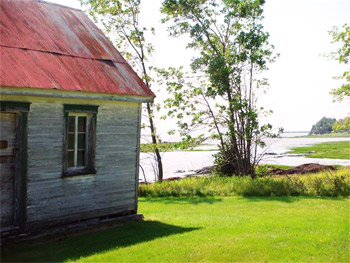Classée au second rang : Rebecca Szulhan, Grosse Île

Faites défiler la liste vers le bas pour voir le diaporama des images de notre gagnante et des finalistes en plus de celles de quelques participants au concours.
Just passing through...
Faces, bedecked in wide-brimmed hats and bonnets, peer down at us from the wharf above our heads, welcoming us as we squint back at them, the sun in our eyes.
My mother and I clamber off the boat with the other tourists. My feet, when I step onto the firm footing of the wharf, briefly remember the sway of the waves before becoming land legs once more. Grosse Île. I spare a moment to consider the hundreds of years' worth of first steps taken on this very wharf, but I can't afford to dawdle. Time is short and there is much to see.
For more than a hundred years (1832-1937), Grosse Île was the site of a quarantine station, hence the moniker: "Gateway to the Saint Lawrence." It was the penultimate stop in a trans-Atlantic voyage, where emigrants disembarked for inspection before continuing up the river to their final destinations. Tour guides, speaking both French and English, recount these journeys as we traverse the island, beginning with a walking tour through the disinfection station. Here, health checks, immunizations and cleaning facilities for luggage were the first defences against disease.
The tour continues by trolley, which wends through a gate in the fence that separates the hospital sector from the rest of the island. Grosse Île was home to more than a quarantine station, and the fence is a stark reminder of the real fear of disease that the permanent residents of this community faced each spring and summer. A stop at the lazaretto, with its fiery red-room (considered therapeutic for smallpox), offers a glimpse into cutting-edge 19th-century medicine. There are two chapels on the island: one Roman Catholic, the other Anglican. On the day of our visit, sunlight streaming through their stained-glass windows, both chapels are restful and welcoming. It's easy to imagine people finding solace within these walls, particularly during times of sickness.
Of all the years the quarantine station operated, 1847 has left perhaps the most indelible mark. Everyone on the island was affected in some way by that year's typhus epidemic, but the disease was particularly deadly for the multitudinous Irish emigrants escaping Ireland's famine. Weakened by malnutrition and weeks spent in the bowels of poorly retrofitted cargo ships, many did not survive the illness. Pristinely white grave-markers speckle the cemetery and a serpentine glass wall bears the names of the dead. A repository for the final stories of more than 7,000 people, Grosse Île has the hushed quality of a living memorial.
Yet, for many others who trod its paths, Grosse Île was simply a transition between the chapters of their lives. From these various beginnings, middles, and ends, the island has anthologized its own history, and the collection continues to grow. If we were to return to the island today and attempt to retrace our exact footsteps, my mother and I would find that they have become indistinguishable from the countless others that passed through the gateway on their way to somewhere else.